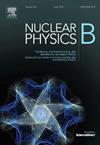具有自组织临界的连续模型的重整化群分析:随机移动环境的影响
IF 2.8
3区 物理与天体物理
Q2 PHYSICS, PARTICLES & FIELDS
引用次数: 0
摘要
我们研究了一个与各向同性随机流体环境耦合的强各向异性自组织临界系统。前者由Hwa和Kardar的连续(粗粒度)模型描述。后者由具有相当一般形式的随机搅拌力的Navier-Stokes方程建模,其中特别包括系统的整体振动和具有幂律谱~ k4−d−y的非局部部分,该幂律谱在极限情况y→4下描述湍流。这两个耦合随机方程的完整问题被表示为一个在d=4时是相乘可重整的和对数的场论模型。由于各向同性和各向异性相互作用之间的相互作用,相应的重整化群(RG)方程揭示了各种格林函数渐近行为的可能红外(大尺度,长时间)机制的丰富模式。在耦合参数的五维空间中,RG方程的吸引子包括一个高斯(自由)不动点的二维曲面,一个单一的不动点对应于湍流的平流(Hwa-Kardar自相互作用无关)和一个一维的不动点曲线,对应于Hwa-Kardar非线性和均匀搅拌同时相关的情况。吸引度的特征由指数y和空间维数d决定;最有趣的情况是d=3且y→4由单不动点描述。准确地求出了相应的频率和基本场的临界尺寸。本文章由计算机程序翻译,如有差异,请以英文原文为准。
Renormalization group analysis of a continuous model with self-organized criticality: Effects of randomly moving environment
We study a strongly anisotropic self-organized critical system coupled to an isotropic random fluid environment. The former is described by a continuous (coarse-grained) model due to Hwa and Kardar. The latter is modelled by the Navier—Stokes equation with a random stirring force of a rather general form that includes, in particular, the overall shaking of the system and a non-local part with power-law spectrum that describes, in the limiting case , a turbulent fluid. The full problem of the two coupled stochastic equations is represented as a field theoretic model which is shown to be multiplicatively renormalizable and logarithmic at . Due to the interplay between isotropic and anisotropic interactions, the corresponding renormalization group (RG) equations reveal a rich pattern of possible infrared (large scales, long times) regimes of asymptotic behaviour of various Green's functions. The attractors of the RG equations in the five-dimensional space of coupling parameters include a two-dimensional surface of Gaussian (free) fixed points, a single fixed point that corresponds to the plain advection by the turbulent fluid (the Hwa–Kardar self-interaction is irrelevant) and a one-dimensional curve of fixed points that corresponds to the case where the Hwa–Kardar nonlinearity and the uniform stirring are simultaneously relevant. The character of attractiveness is determined by the exponent y and the dimension of space d; the most interesting case and is described by the single fixed point. The corresponding critical dimensions of the frequency and the basic fields are found exactly.
求助全文
通过发布文献求助,成功后即可免费获取论文全文。
去求助
来源期刊

Nuclear Physics B
物理-物理:粒子与场物理
CiteScore
5.50
自引率
7.10%
发文量
302
审稿时长
1 months
期刊介绍:
Nuclear Physics B focuses on the domain of high energy physics, quantum field theory, statistical systems, and mathematical physics, and includes four main sections: high energy physics - phenomenology, high energy physics - theory, high energy physics - experiment, and quantum field theory, statistical systems, and mathematical physics. The emphasis is on original research papers (Frontiers Articles or Full Length Articles), but Review Articles are also welcome.
 求助内容:
求助内容: 应助结果提醒方式:
应助结果提醒方式:


